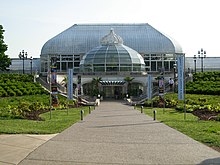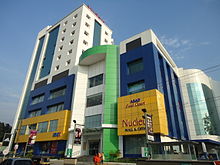Leadership in Energy and Environmental Design
From Wikipedia, the free encyclopedia
Leadership in Energy and Environmental Design (LEED) is one of the most popular green building certification programs used worldwide.[7] Developed by the non-profit U.S. Green Building Council (USGBC) it includes a set of rating systems for the design, construction, operation, and maintenance of green buildings, homes, and neighborhoods[8] that aims to help building owners and operators be environmentally responsible and use resources efficiently.
History[edit]
From 1994 to 2015, LEED grew from one standard for new construction to a comprehensive system of interrelated standards covering aspects from the design and construction to the maintenance and operation of buildings. LEED also has grown from six volunteers on one committee to 119,924 staff, volunteers and professionals.[9] LEED standards have been applied to approximately 83,452 registered and certified LEED projects worldwide, covering around 13.8 billion square feet (1.28 billion square meters).[10]
Many U.S. federal agencies and state and local governments require or reward LEED certification. However, four states (Alabama, Georgia, Maine, and Mississippi) have effectively banned the use of LEED in new public buildings, preferring other industry standards that the USGBC considers too lax.[11]
Unlike model building codes, such as the International Building Code, only members of the USGBC and specific "in-house" committees may add to, subtract from, or edit the standard, subject to an internal review process. Proposals to modify the LEED standards are offered and publicly reviewed by USGBC's member organizations, which number almost 12,216.[9]
USGBC's Green Business Certification Inc. (GBCI) offers various accreditation to people who demonstrate knowledge of the LEED rating system, including LEED Accredited Professional (LEED AP), LEED Green Associate,[12] and since 2011, LEED Fellows, the highest designation for LEED professionals. GBCI also certifies projects pursuing LEED.
Rating systems[edit]
LEED has evolved since 1998 to more accurately represent and incorporate emerging green building technologies. The pilot version, LEED New Construction (NC) v1.0, led to LEED NCv2.0, LEED NCv2.2 in 2005, and LEED 2009 (previously named LEED v3) in 2009. LEED v4 was introduced in November, 2013. Until October 31, 2016, new projects may choose between LEED 2009 and LEED v4. New projects registering after October 31, 2016 must use LEED v4.[13]
LEED 2009 encompasses ten rating systems for the design, construction and operation of buildings, homes and neighborhoods.[8] Five overarching categories correspond to the specialties available under the LEED professional program. That suite currently consists of:
Green Building Design & Construction
- LEED for New Construction
- LEED for Core & Shell
- LEED for Schools
- LEED for Retail: New Construction and Major Renovations
- LEED for Healthcare
Green Interior Design & Construction
- LEED for Commercial Interiors
- LEED for Retail: Commercial Interiors
Green Building Operations & Maintenance
- LEED for Existing Buildings: Operations & Maintenance
Green Neighborhood Development
- LEED for Neighborhood Development[8]
Green Home Design and Construction
- LEED for Homes (The LEED for Homes rating system is different from LEED v3, with different point categories and thresholds that reward efficient residential design.[citation needed])
LEED also forms the basis for other sustainability rating systems such as the Environmental Protection Agency's Labs21.
To make it easier to follow LEED requirements, in 2009 USGBC helped BuildingGreen develop LEEDuser, a guide to the LEED certification process and applying for LEED credits written by professionals in the field.[14]
LEED 2009[edit]
After four years of development, aligning credits across all LEED rating systems and weighting credits based on environmental priority, USGBC launched LEED v3,[15] which consists of a new continuous development process, a new version of LEED Online, a revised third-party certification program and a new suite of rating systems known as LEED 2009.
Under LEED 2009, there are 100 possible base points distributed across six credit categories: Sustainable Sites, Water Efficiency, Energy and Atmosphere, Materials and Resources, Indoor Environmental Quality, Innovation in Design. Up to 10 additional points may be earned: four additional points may be received for Regional Priority Credits, and six additional points for Innovation in Design (which includes exemplary performance credits for existing credit categories).
Certification level[edit]
Buildings can qualify for four levels of certification:
- Certified: 40–49 points
- Silver: 50–59 points
- Gold: 60–79 points
- Platinum: 80 points and above
Goal of the credit system[edit]
The LEED 2009 performance credit system aims to allocate points "based on the potential environmental impacts and human benefits of each credit." These are weighed using the environmental impact categories of the United States Environmental Protection Agency's Tools for the Reduction and Assessment of Chemical and Other Environmental Impacts (TRACI).[16] and the environmental-impact weighting scheme developed by the National Institute of Standards and Technology (NIST).
Prerequisites[edit]
To participate in LEED 2009, a building must comply with environmental laws and regulations, occupancy scenarios, building permanence and pre-rating completion, site boundaries and area-to-site ratios. Its owner must share data on the building's energy and water use for five years after occupancy (for new construction) or date of certification (for existing buildings).[17]
Each of the performance categories also have mandatory measures in each category, which receive no points.
Credit weighting process[edit]
The weighting process has three steps:[18]
- A collection of reference buildings are used to estimate the environmental impacts of any building seeking LEED certification in a designated rating scheme.
- NIST weightings are used to judge the relative importance of these impacts in each category.
- Data regarding actual impacts on environmental and human health are used to assign points to individual categories and measures.
This system results in a weighted average for each rating scheme based upon actual impacts and the relative importance of those impacts to human health and environmental quality.
The LEED council also appears to have assigned credit and measure weighting based upon the market implications of point allocation.[18]
From 2010, buildings can use carbon offsets to achieve Green Power Credits for LEED-NC (New Construction Certification) :[19]
LEED for Homes[edit]
Additional performance categories in the LEED for Homes rating system are Locations and Linkages (recognizing the importance of transportation access, open space, and physical activity outdoors) and Awareness and Education (recognizing the need for buildings and settlements to educate occupants).
LEED Canada[edit]
In 2003, the Canada Green Building Council received permission to create LEED Canada-NC v1.0, which was based upon LEED-NC 2.0.[20][21] Many buildings in Canada are LEED certified in part due to their Rainwater harvesting practices.
Process[edit]
LEED certification is granted by the Green Building Certification Institute (GBCI), which handles the third-party verification of a project's compliance with the LEED requirements.
The certification process for design teams is made up of two consecutive applications: one including design credits, and one including construction credits. All of the LEED credits in each rating system are assigned to either the design application or the construction application. The design credits include those that are the purview of the architect and the engineer, and are documented in the official construction drawings. The construction credits include those that are predominantly under the purview of the contractor, and are documented during the construction and commissioning of the building.
A fee is required to register the building, and to submit the design and construction applications. Total fees are assessed based on building area. Fees range from a minimum of $2,900 to over $1 million for a large project.[22] "Soft" costs, i.e., added costs to the building project to quality for LEED certification, range from 1% to 6% of the total project cost. The average cost increase was about 2%, or an extra $3–$5 per square foot.[23]
The application review and certification process is handled on LEED Online, USGBC's web-based service that employs a series of active PDF forms to allow project teams to fill out credit forms and upload supporting documentation online. The GBCI also utilizes LEED Online to conduct their reviews.
LEED energy modeling[edit]
Design teams have the option of achieving points under the Optimize Energy Performance credit by building an energy model. This energy model must follow the modeling methodologies outlined in Appendix G of the ASHRAE 90.1 building energy standard. The guidelines in Appendix G require that the team make two energy models: one representing the building as designed, and a second “baseline” building. The baseline building must be modeled in the same location, and have the same geometry and occupancy as the design building. Depending on location (climate) and building size, the standard provides requirements for HVAC system type, and wall and window definitions. The goal of this methodology is to provide a baseline building to use as a reference point to compare the design building against. It is a way to standardize the baseline, while putting weight on important factors that heavily influence building energy consumption (e.g., location, geometry, and occupancy patterns). The number of points achieved in this credit is correlated with the percent predicted energy cost savings demonstrated by the difference between the design and baseline energy models.
This method of energy modeling has been criticized for inaccurately predicting actually energy usage of LEED-certified buildings. The USGBC admits that "current information indicates that most buildings do not perform as well as design metrics indicate. As a result, building owners might not obtain the benefits promised."[24]
LEED for Homes Rating System[edit]
Today, Increasing demand towards environment safety, force LEED certification to play major role. The process of the LEED for Homes Rating System, available in the USA,[25]Canada and Sweden[26] is significantly different from the LEED NC rating system. LEED for Homes projects are low rise residential and are required to work with either an American Provider Organization[27] or a Canadian Provider Organization[28] and a Green Rater. A Provider Organization helps the project through the process while overseeing the Green Raters. Green Raters are individuals that conduct the two mandatory LEED for Homes site inspections; the Thermal Bypass Inspection and the Final Inspection. Although LEED for Homes is typically viewed by the construction industry as a simpler rating system especially when compared to LEED NC, LEED NC does not require an on-site inspection. The Provider and the Green Rater do not certify the project, but rather assist in the certification process.
REFERENCE:
https://en.wikipedia.org/wiki/Leadership_in_Energy_and_Environmental_Design
PERSONAL OPINION:
This method of energy modeling has been criticized for inaccurately predicting actually energy usage of LEED-certified buildings. The USGBC admits that "current information indicates that most buildings do not perform as well as design metrics indicate. As a result, building owners might not obtain the benefits promised.
PERSONAL OPINION:
This method of energy modeling has been criticized for inaccurately predicting actually energy usage of LEED-certified buildings. The USGBC admits that "current information indicates that most buildings do not perform as well as design metrics indicate. As a result, building owners might not obtain the benefits promised.









No comments:
Post a Comment